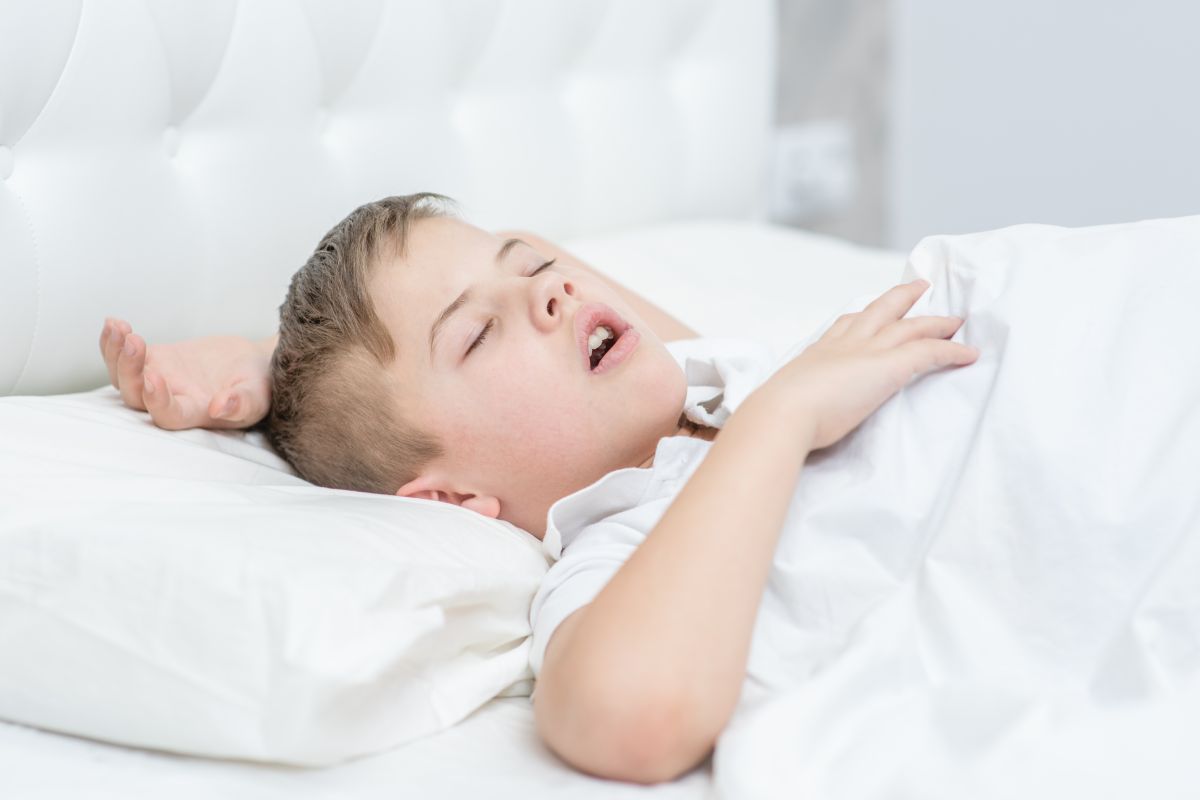When Sarah noticed her 8-year-old son Jake snoring loudly every night and struggling to pay attention in school, she initially thought it was just a phase. But after his teacher mentioned that Jake seemed tired during class and was having trouble focusing, Sarah began to wonder if something more serious was happening. What she discovered changed everything: Jake was suffering from a sleep breathing disorder that was affecting not just his nights, but his days as well.
Jake’s story isn’t unique. Childhood sleep breathing disorders are far more common than most parents realize, and they can have profound effects on a child’s health, development, and academic performance. The good news? Early orthodontic intervention can often help address the underlying causes and dramatically improve a child’s quality of life.
Understanding Childhood Sleep Breathing Disorders
Sleep-disordered breathing (SDB) in children ranges from simple snoring to more serious conditions like obstructive sleep apnea (OSA). These disorders occur when the upper airway becomes partially or completely blocked during sleep, disrupting normal breathing patterns and sleep quality¹.
Unlike adults who may simply feel tired after a poor night’s sleep, children with sleep breathing disorders often exhibit symptoms that can be mistaken for other issues. Parents might notice their child is hyperactive, has difficulty concentrating, or struggles academically – symptoms that are sometimes misdiagnosed as ADHD when the real culprit is poor sleep quality due to breathing problems.
The connection between orthodontic issues and sleep breathing disorders is significant. Children seeking orthodontic care actually have a higher prevalence of sleep breathing disorders compared to the general pediatric population². This makes the orthodontist’s office an ideal place for early screening and intervention.
Recognizing the Warning Signs
Many parents don’t realize that what they’re observing at home could be signs of a serious sleep disorder. The symptoms of childhood sleep breathing disorders often extend far beyond the bedroom:
Nighttime Symptoms
- Loud, persistent snoring, especially if it occurs most nights
- Pauses in breathing during sleep that may be followed by gasping
- Restless sleep with frequent tossing and turning
- Mouth breathing during sleep instead of nasal breathing
Daytime Symptoms
- Difficulty concentrating at school or during homework
- Behavioral problems including hyperactivity or irritability
- Excessive daytime sleepiness or difficulty waking up
- Poor academic performance despite normal intelligence
The challenge for parents is that these daytime symptoms can easily be attributed to other causes. A child who seems hyperactive might be labeled as having behavioral issues, when in reality, they’re simply exhausted from poor sleep quality caused by breathing problems.
The Orthodontic Connection
There’s a strong relationship between certain facial and dental development patterns and sleep breathing disorders. Children with narrow upper jaws, receding lower jaws, or specific bite problems are at higher risk for airway issues³. This is where early orthodontic intervention can make a significant difference.
Traditional orthodontic treatment focuses primarily on straightening teeth and correcting bites. However, modern orthodontics takes a more comprehensive approach, considering how dental and facial development affects overall health – including breathing and sleep quality.
When orthodontists evaluate children for treatment, they’re not just looking at crooked teeth. They’re also assessing facial development patterns, jaw relationships, and airway function. This comprehensive evaluation allows them to identify children who might benefit from early intervention to improve both their orthodontic needs and their breathing.
How Early Intervention Makes a Difference
Early orthodontic intervention for sleep breathing disorders typically focuses on addressing the anatomical factors that contribute to airway obstruction. The most common and effective treatment is rapid maxillary/palatal expansion (RME or RPE), a procedure that widens the upper jaw to create more space for proper breathing.
Rapid Maxillary Expansion: A Game-Changer
RME involves using a special appliance to gradually widen the upper jaw over a period of several weeks. This expansion has multiple benefits for children with sleep breathing disorders. By widening the upper jaw, RME increases the nasal cavity space, which can significantly reduce nasal airway resistance and improve airflow⁴.
Studies show that RME can significantly reduce the apnea-hypopnea index (AHI) – a measure of sleep apnea severity – and increase oxygen saturation in children with OSA. These improvements have been observed up to 12 months after treatment, suggesting lasting benefits⁵.
The timing of RME is crucial. The procedure is most effective when performed during periods of active growth, typically between ages 7-14. During this time, the bones of the upper jaw haven’t fully fused, making expansion easier and more stable.
Functional Appliances and Airway Development
In addition to RME, orthodontists may use functional appliances to help improve airway function. These devices work by encouraging proper jaw growth and positioning, which can create more space for the tongue and improve overall airway dimensions.
Functional appliances are particularly beneficial for children with small or receding lower jaws, a condition that can contribute to airway obstruction. By encouraging forward growth of the lower jaw, these appliances can help create more space in the throat area, reducing the likelihood of airway collapse during sleep.
The Science Behind the Treatment
The evidence supporting early orthodontic intervention for childhood sleep breathing disorders continues to grow. Research shows that certain orthodontic treatments can lead to meaningful improvements in breathing and sleep quality:
- Functional appliances have been associated with significant improvements in upper airway volume and reduction in airway constriction⁶
- RME treatment can significantly increase nasal cavity and nasopharyngeal dimensions⁷
- Mandibular advancement devices can reduce OSA severity and improve oxygen saturation⁸
However, it’s important to understand that not every child with sleep breathing disorders will benefit from orthodontic treatment alone. The most significant improvements are often seen when orthodontic intervention is combined with other therapies, such as addressing enlarged tonsils and adenoids.
A Multidisciplinary Approach
Effective treatment of childhood sleep breathing disorders often requires a team approach. While orthodontists play a crucial role in addressing anatomical factors that contribute to airway obstruction, other specialists may also be involved:
Pediatric Sleep Specialists can conduct comprehensive sleep studies to accurately diagnose the severity of sleep disorders and monitor treatment progress.
ENT Specialists may recommend removal of enlarged tonsils and adenoids, which are common contributors to airway obstruction in children.
Pediatricians help coordinate care and monitor overall health and development throughout treatment.
This collaborative approach ensures that all factors contributing to a child’s sleep breathing disorder are addressed comprehensively.
What Parents Can Expect
If your child is identified as having sleep breathing disorders that might benefit from orthodontic intervention, here’s what you can typically expect:
Initial Evaluation: A comprehensive assessment that includes examining facial development, jaw relationships, and airway function. This may involve taking special X-rays or 3D scans to evaluate airway dimensions.
Treatment Planning: If orthodontic intervention is recommended, your orthodontist will explain the proposed treatment, timeline, and expected outcomes. Treatment plans are always individualized based on your child’s specific needs.
Active Treatment: Depending on the approach, treatment might involve wearing an expansion appliance for several weeks or months, followed by a retention phase to maintain the improvements.
Monitoring and Follow-up: Regular appointments to monitor progress and make adjustments as needed. Your orthodontist may also coordinate with other specialists involved in your child’s care.
The Benefits Beyond Better Sleep
While the primary goal of early orthodontic intervention for sleep breathing disorders is to improve breathing and sleep quality, the benefits often extend far beyond the bedroom. Parents frequently report improvements in their child’s:
- Academic performance as concentration and focus improve
- Behavior and mood as sleep quality enhances overall well-being
- Energy levels throughout the day
- Overall health as proper sleep supports immune function and growth
Many families are amazed by the transformation they see in their children once sleep breathing issues are addressed. Children who were previously struggling in school often see dramatic improvements in their ability to focus and learn.
Early Intervention: The Key to Success
The importance of early identification and intervention cannot be overstated. Sleep breathing disorders that go untreated can have long-lasting effects on a child’s health, development, and quality of life. The earlier these issues are identified and addressed, the better the outcomes tend to be.
This is why many orthodontists now include sleep breathing disorder screening as part of their routine evaluations. The American Association of Orthodontists recommends that children have their first orthodontic evaluation by age 7, which coincides with the optimal time for identifying and addressing sleep breathing issues.
When to Seek Help
If you’ve noticed any signs that might suggest your child has a sleep breathing disorder, don’t wait to seek professional help. Contact your child’s pediatrician or an orthodontist who has experience with sleep breathing disorders for an evaluation.
Early signs that warrant professional evaluation include persistent snoring, restless sleep, mouth breathing, daytime fatigue, difficulty concentrating, or behavioral issues that might be related to poor sleep quality.
Looking Forward
The field of orthodontics continues to evolve in its understanding and treatment of childhood sleep breathing disorders. Ongoing research is helping to refine treatment protocols and identify which children are most likely to benefit from specific interventions.
What remains clear is that early orthodontic intervention can play a valuable role in addressing childhood sleep breathing disorders, often leading to improvements that extend far beyond straight teeth to encompass better health, improved academic performance, and enhanced quality of life.
The Bottom Line
Childhood sleep breathing disorders are serious conditions that can have far-reaching effects on a child’s health and development. However, with early identification and appropriate intervention, these issues can often be successfully addressed.
If you suspect your child might have a sleep breathing disorder, don’t hesitate to seek professional evaluation. Early orthodontic intervention, when appropriate, can make a profound difference in your child’s health, sleep quality, and overall well-being.
Remember, the goal isn’t just to create a beautiful smile – it’s to help your child breathe better, sleep better, and ultimately, live better. That’s the true power of early orthodontic intervention for childhood sleep breathing disorders.
References
- Alarcon, K., Ramírez, E., Quintero, M., Trejo, C., Reyes, L., Cepeda, M., & Solís-Soto, J. (2021). Sleep-disordered breathing in children. International Journal of Applied Dental Sciences. https://doi.org/10.22271/oral.2021.v7.i3d.1304
- Abtahi, S., Witmans, M., Alsufyani, N., Major, M., & Major, P. (2020). Pediatric sleep-disordered breathing in the orthodontic population: Prevalence of positive risk and associations. American Journal of Orthodontics and Dentofacial Orthopedics, 157(4), 466-473.e1. https://doi.org/10.1016/j.ajodo.2019.05.015
- Orbach, H., Wexler, A., Orbach, A., Gross, M., & Shalish, M. (2022). Sleep-related breathing disorders in young orthodontic patients. American Journal of Orthodontics and Dentofacial Orthopedics. https://doi.org/10.1016/j.ajodo.2021.09.017
- Ferati, K., Bexheti-Ferati, A., Palermo, A., Pezzolla, C., Trilli, I., Sardano, R., Latini, G., Inchingolo, A., Inchingolo, A., Malcangi, G., Inchingolo, F., Dipalma, G., & Mancini, A. (2024). Diagnosis and Orthodontic Treatment of Obstructive Sleep Apnea Syndrome Children—A Systematic Review. Diagnostics, 14. https://doi.org/10.3390/diagnostics14030289
- Bucci, R., Rongo, R., Zunino, B., Michelotti, A., Bucci, P., Alessandri-Bonetti, G., Incerti-Parenti, S., & D’antò, V. (2022). Effect of orthopedic and functional orthodontic treatment in children with obstructive sleep apnea: A systematic review and meta-analysis. Sleep Medicine Reviews, 67, 101730. https://doi.org/10.1016/j.smrv.2022.101730
- Abdalla, Y., & Sonnesen, L. (2024). Association between orthodontic treatment and upper airway changes in children assessed with cone-beam computed tomography (CBCT): A systematic review. Journal of Oral Rehabilitation. https://doi.org/10.1111/joor.13797
- Cohen-Lévy, J. (2023). The influence of obstructive sleep apnea syndrome on the orthodontic treatment decision in children and adolescents. Part 2: Which orthodontic treatments for children with apnea? L’Orthodontie Française, 94(1), 173-185. https://doi.org/10.1684/orthodfr.2023.116
- Yu, M., Xu, Y., Bai, J., Lu, Y., Han, F., & Gao, X. (2023). Orthodontic appliances for the treatment of pediatric obstructive sleep apnea: A systematic review and network meta-analysis. Sleep Medicine Reviews, 72, 101855. https://doi.org/10.1016/j.smrv.2023.101855





